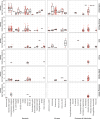Zoonotic and Environmental Sources of Infant Enteric Pathogen Infections Identified with Longitudinal Sampling
- PMID: 40550103
- PMCID: PMC12243083
- DOI: 10.1021/acs.est.5c02027
Zoonotic and Environmental Sources of Infant Enteric Pathogen Infections Identified with Longitudinal Sampling
Abstract
Many enteric pathogens that infect young children can be zoonotic, yet the exposure risk of domestic animals living in close proximity to young children is poorly understood. Here, we longitudinally measured 33 enteric pathogens in child stool, animal feces, and the household environment (n = 28,743 pathogen-sample observations) to investigate pathogen transmission between animals and children under two in pastoralist communities in rural Northern Kenya. Children were typically infected with 1 enteric pathogen by 3 months of age, and pathogen burden increased with age; 85% of enteric pathogens detected in child stool were also detected in animal feces. New infections in children were associated with preceding household detection of the same pathogen in soil (Odds ratio: 8.8, 95% confidence interval: 3.3-23) and on child hands (odds ratio: 5.0, 95% confidence interval 1.1-17). Regression modeling revealed transmission of pathogens from poultry, dog, and ruminant feces to household soil, and between child hands and child stool. Our results provide new evidence that domestic animals in the household environment contribute to early life enteric pathogen exposure, and that child hand hygiene could substantially prevent animal-child transmission.
Keywords: environmental microbiology; exposure assessment; zoonotic pathogen transmission.
Figures





Similar articles
-
Is detection of enteropathogens and human or animal faecal markers in the environment associated with subsequent child enteric infections and growth: an individual participant data meta-analysis.Lancet Glob Health. 2024 Mar;12(3):e433-e444. doi: 10.1016/S2214-109X(23)00563-6. Lancet Glob Health. 2024. PMID: 38365415 Free PMC article.
-
Potential pathogens and antimicrobial resistance genes in household environments: a study of soil floors and cow dung in rural Bangladesh.Appl Environ Microbiol. 2025 Jun 18;91(6):e0066925. doi: 10.1128/aem.00669-25. Epub 2025 May 27. Appl Environ Microbiol. 2025. PMID: 40422288 Free PMC article.
-
Household interventions for preventing domestic lead exposure in children.Cochrane Database Syst Rev. 2016 Oct 16;10(10):CD006047. doi: 10.1002/14651858.CD006047.pub5. Cochrane Database Syst Rev. 2016. Update in: Cochrane Database Syst Rev. 2020 Oct 6;10:CD006047. doi: 10.1002/14651858.CD006047.pub6. PMID: 27744650 Free PMC article. Updated.
-
Evaluating impacts of improved flooring on enteric and parasitic infections in rural households in Kenya: study protocol for a cluster-randomised controlled trial.BMJ Open. 2025 Jun 6;15(6):e090464. doi: 10.1136/bmjopen-2024-090464. BMJ Open. 2025. PMID: 40480665 Free PMC article.
-
Physical interventions to interrupt or reduce the spread of respiratory viruses.Cochrane Database Syst Rev. 2023 Jan 30;1(1):CD006207. doi: 10.1002/14651858.CD006207.pub6. Cochrane Database Syst Rev. 2023. PMID: 36715243 Free PMC article.
References
-
- Thystrup C., Majowicz S. E., Kitila D. B., Desta B. N., Fayemi O. E., Ayolabi C. I., Hugho E., Buys E. M., Akanni G. B., Machava N. E., Monjane C., Hald T., Pires S. M.. Etiology-Specific Incidence and Mortality of Diarrheal Diseases in the African Region: A Systematic Review and Meta-Analysis. BMC Public Health. 2024;24(1):1864. doi: 10.1186/s12889-024-19334-8. - DOI - PMC - PubMed
-
- Liu J., Platts-Mills J. A., Juma J., Kabir F., Nkeze J., Okoi C., Operario D. J., Uddin J., Ahmed S., Alonso P. L., Antonio M., Becker S. M., Blackwelder W. C., Breiman R. F., Faruque A. S. G., Fields B., Gratz J., Haque R., Hossain A., Hossain M. J., Jarju S., Qamar F., Iqbal N. T., Kwambana B., Mandomando I., McMurry T. L., Ochieng C., Ochieng J. B., Ochieng M., Onyango C., Panchalingam S., Kalam A., Aziz F., Qureshi S., Ramamurthy T., Roberts J. H., Saha D., Sow S. O., Stroup S. E., Sur D., Tamboura B., Taniuchi M., Tennant S. M., Toema D., Wu Y., Zaidi A., Nataro J. P., Kotloff K. L., Levine M. M., Houpt E. R.. Use of Quantitative Molecular Diagnostic Methods to Identify Causes of Diarrhoea in Children: A Reanalysis of the GEMS Case-Control Study. Lancet. 2016;388(10051):1291–1301. doi: 10.1016/S0140-6736(16)31529-X. - DOI - PMC - PubMed
-
- Tickell K. D., Sharmin R., Deichsel E. L., Lamberti L. M., Walson J. L., Faruque A. S. G., Pavlinac P. B., Kotloff K. L., Chisti M. J.. The Effect of Acute Malnutrition on Enteric Pathogens, Moderate-to-Severe Diarrhoea, and Associated Mortality in the Global Enteric Multicenter Study Cohort: A Post-Hoc Analysis. Lancet Glob. Health. 2020;8(2):e215–e224. doi: 10.1016/S2214-109X(19)30498-X. - DOI - PMC - PubMed
-
- Nuclear Regulatory Commission . NUTRITIONAL CONSEQUENCES OF ACUTE DIARRHEA. In Nutritional Management of Acute Diarrhea in Infants and Children; National Academies Press (US), 1985. - PubMed
MeSH terms
LinkOut - more resources
Full Text Sources
Medical

